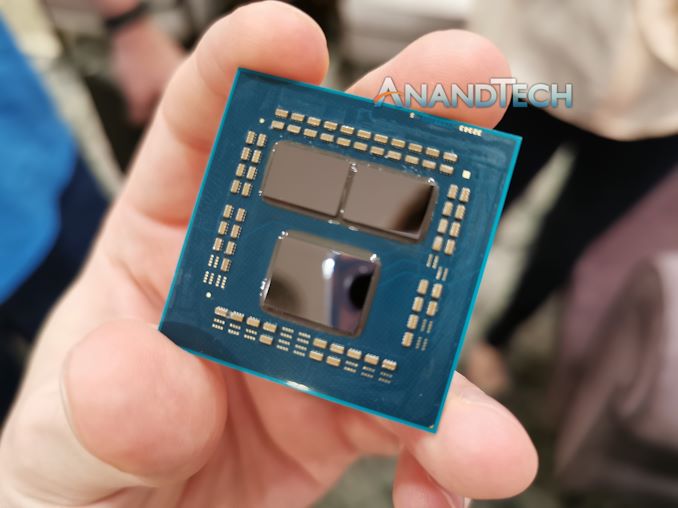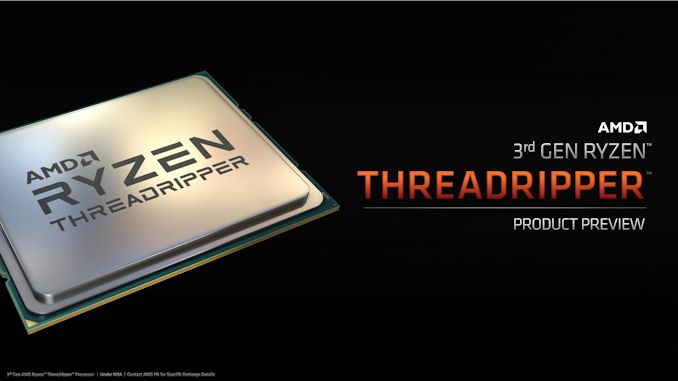AMD Q4: 16-core Ryzen 9 3950X, Threadripper Up To 32-Core 3970X, Coming November 25th
by Dr. Ian Cutress on November 7, 2019 9:00 AM EST
AMD is set to close out the year on a high note. As promised, the company will be delivering its latest 16-core Ryzen 9 3950X processor, built with two 7nm TSMC chiplets, to the consumer platform for $749. Not only this, but AMD today has lifted the covers on its next generation Threadripper platform, which includes Zen 2-based chiplets, a new socket, and an astounding 4x increase in CPU-to-chipset bandwidth.
This year AMD is presenting its ‘Fall 2019 Desktop Update’, covering the new products for the holiday season. Q4 is historically a good target for increased consumer sales, as long as the products hit the right price point and are available in volume for the peak shopping periods. We’ve been waiting mercilessly for more details about the crème-de-la-crème of what AMD has to offer with its 7nm product portfolio for both mainstream Ryzen desktop processors, but also the creator and workstation focused 3rd Gen Threadripper. After continuously requesting information from CEO Lisa Su since the middle of the year, AMD is lifting the lid on the product details, pricing, and launch dates.
The short version of today’s announcement revolves around several parts, in completely different markets.
- The Ryzen 9 3950X 16-core CPU for desktops
- Ryzen Threadripper 3rd Gen Family: Starting with the 24-core 3960X and 32-core 3970X
- New TRX40 motherboards for the new Threadripper Processors
- A new $49 Athlon 3000G for the entry level market
All of this hardware is set to come to market through the month of November at the following dates:
- Ryzen 9 3950X: Retail on November 25
- TR 3960X and TR 3970X on November 25th
- TRX40 motherboards on November 25th
- Athlon 3000G on November 19th
One key takeaway from today’s announcements is how AMD is moving the traditional desktop and high-end desktop markets. When CEO Dr. Lisa Su was asked earlier this year what will happen to Threadripper as the mainstream Ryzen family moves ‘up’ in performance, her response was that ‘Threadripper will move up-up’. To that effect, we are seeing AMD’s delineation between mainstream desktop and high-end desktop move up to between 16-core and 24-core, with room at the top for more cores if AMD wants to go that way.

Our Group Interview with Dr. Lisa Su at Computex 2019
This new hardware is also breaking new records for enthusiast CPU TDP values, as well as representing new ground on the latest 7nm process technology now available to the wider market. Details about pricing, TDP, AMD’s strategy, AMD’s performance numbers, TRX40 chipset information, and analysis of the announcements are all inside.












171 Comments
View All Comments
Valantar - Thursday, November 7, 2019 - link
Last I checked $2000 CPUs generally weren't for "casual everyday programs". Not really $750 ones either.Performance hungry productivity applications can on the other hand make use of 16 quite commonly, though 32 is still a stretch. Then again there's some value to a workstation that's fully usable even when running a compile, render, or other multi-hour heavy workload.
evernessince - Thursday, November 7, 2019 - link
People were saying the same thing 3 years ago about the 8 core Zen 1 CPUs and yet here we are, a majority of new games coming out utilizing 8 cores. Give it another 3 years, I wouldn't be surprised to see if that doubles again.Oliseo - Friday, November 8, 2019 - link
Enough with the hyperbole already. Games will NOT be using 16 cores in another 3 years.I know it suits your argument an all, but get real.
Spunjji - Friday, November 8, 2019 - link
Agreed. What's more likely is that we'll see games / engines that depend on 4+ cores becoming commonplace, with maybe an outlier or two that can squeeze marginal gains from 8+.Targon - Friday, November 8, 2019 - link
With the Ryzen 7 release in 2017, and then the release of the i9-9900k, no one questions that we are now in the era where games and programs should at least be able to scale with 8 core/16 threads. Now, once you actually have a properly multi-threaded design, it becomes simple to just use a design to use more and more threads, and if you have fewer cores, no problem because the scheduler will just assign the threads to CPU cores.You don't really target a given number of cores, you either go for a multi-threaded design, or you don't. Allow those who have a higher end processor get the advantage of more cores/threads, it doesn't HURT those with lower tier chips.
jaju123 - Thursday, November 7, 2019 - link
Absolute dominance, I love it. Crazy that I can use my 3700x now (which is already incredibly fast) and buy a used 3950x in a couple of years for an upgrade with double the cores (or just get a zen 3 chip).yeeeeman - Thursday, November 7, 2019 - link
Well, AMD is trying the Intel seat and it likes it. We can see that the 32 core part is now more expensive than the previous gen 32 core part, 2000$ vs 1800$.Irata - Thursday, November 7, 2019 - link
While this is more than many had expected, the only Intel CPU / platform that comes remotely close to the TR3 platform is the 28C Xeon W-3175X, which costs $ 3,000 and requires a separate very expensive mainboard.TheinsanegamerN - Thursday, November 7, 2019 - link
It also brings gen 4 PCIe, which aint cheap.Kjella - Thursday, November 7, 2019 - link
The 32 core TR2 had a very awkward memory architecture where not all the CPUs had direct access to memory and on many workloads it performed no better than a 16 core. If you wanted a "normal" 32 core CPU you'd have to buy EPYC server chips which cost a lot more for much lower speeds. So while you can't read it out of that spec sheet the TR3 is actually a much more capable product.